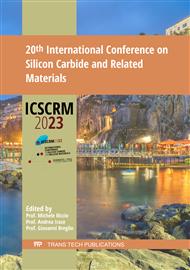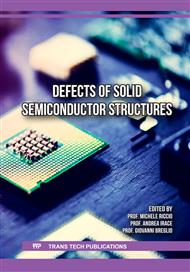p.111
p.117
p.123
p.129
p.135
p.143
p.149
p.157
p.165
Analysis of Defect Structures during the Early-Stages of PVT Growth of 4H-SiC Crystals
Abstract:
To better understand the effects of various growth parameters during the early-stages of PVT growth of 4H-SiC on resulting defect structures, multiple short duration growths have been carried out under varying conditions of seed quality, nucleation rate, thermal gradients, and N incorporation. Besides the replication of TSDs/TMDs and TEDs as well as the deflection of TSDs/TMDs into Frank dislocations, synchrotron monochromatic beam x-ray topography (SMBXT) studies also reveal the formation of stacking faults bounded by Frank dislocations. Using ray tracing simulations to characterize the Frank dislocations, three types of stacking faults are revealed: Type 1 stacking fault resulting from 2D nucleation of 6H polytype on terraces; Type 2 stacking fault resulting from macrostep overgrowth of the surface growth spiral steps of TSDs/TMDs which separate into c/2 or c/4 increments; Type 3 stacking fault resulting from vicinal step overgrowth of surface growth spiral steps of TSDs/TMDs which separate into c/4 and 3c/4 increments. Analysis of atomic resolution scanning transmission electron microscopy (STEM) images reveals the mechanism of the Type 3 fault.
Info:
Periodical:
Pages:
135-142
Citation:
Online since:
August 2024
Keywords:
Permissions:
Share:
Citation:



